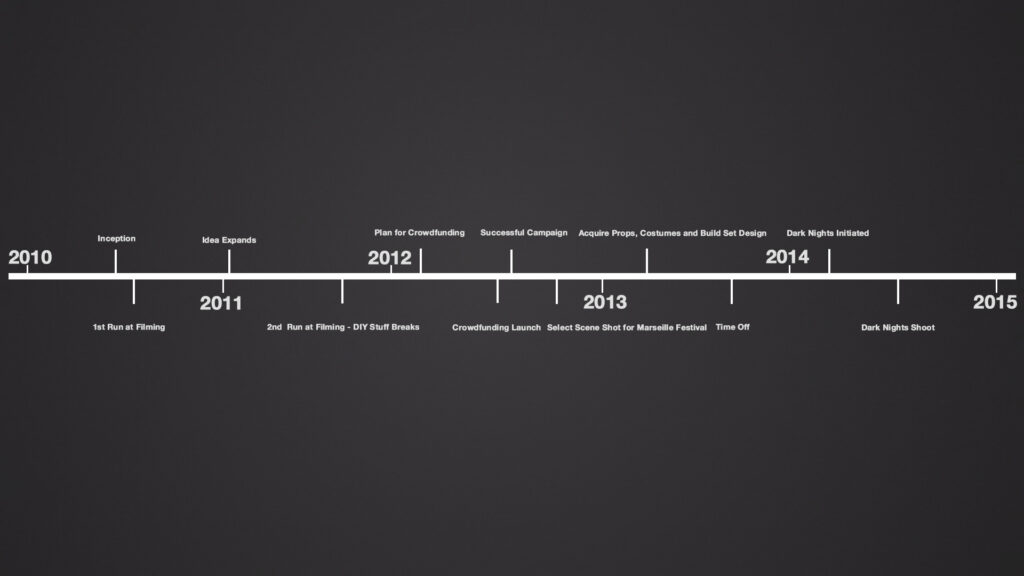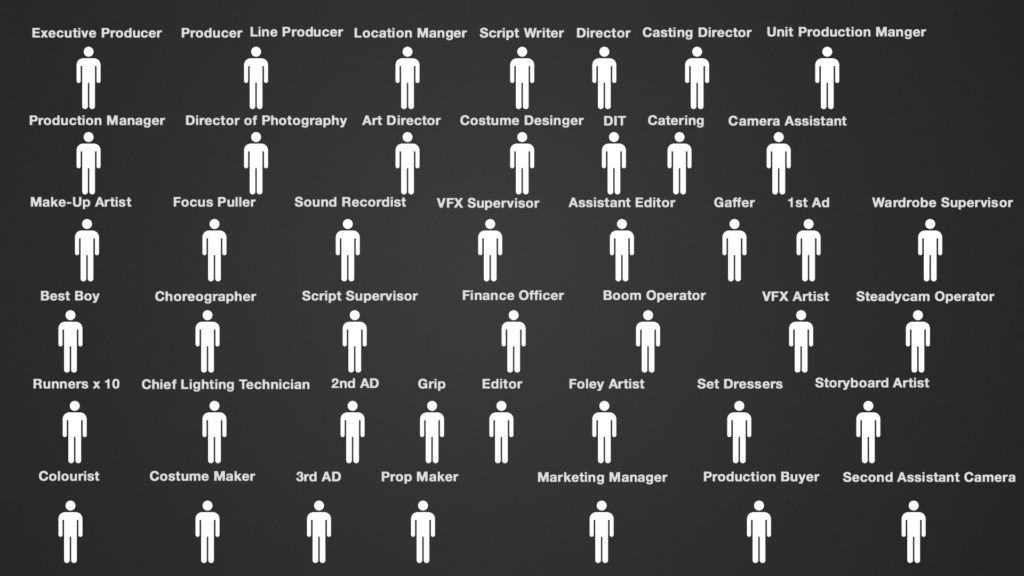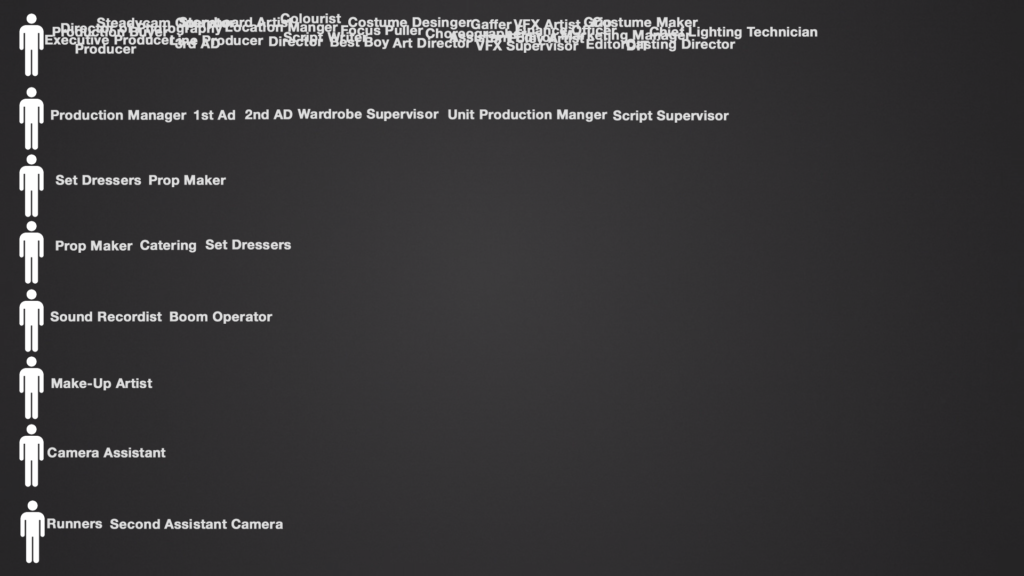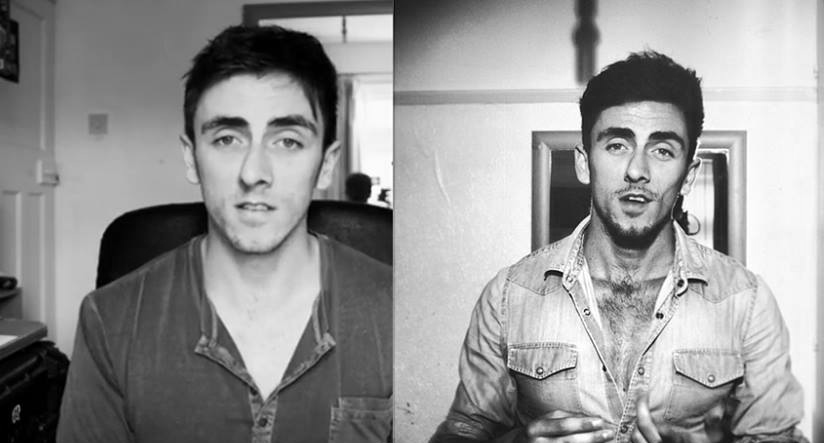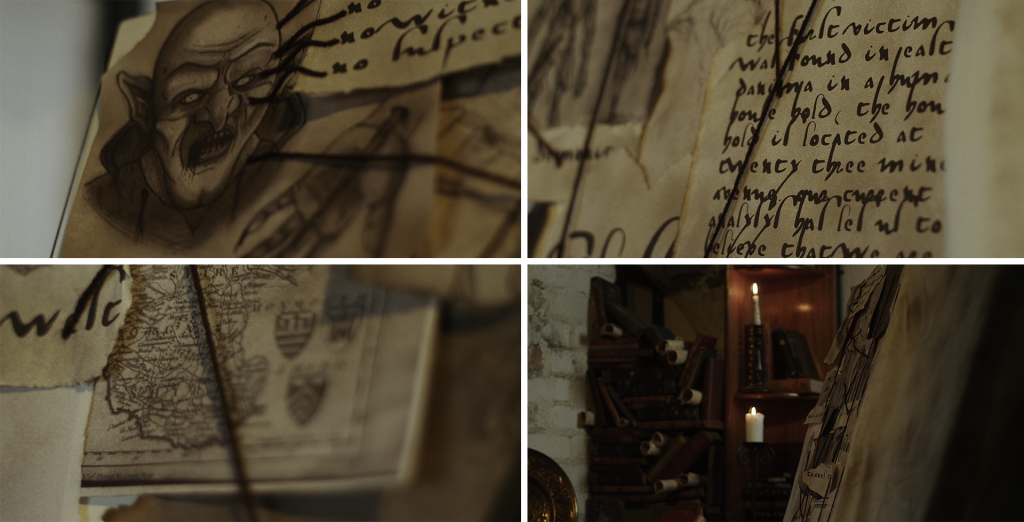One thing that we as DIY filmmakers dream of; is money and exposure. To be the next viral hit. To be burdened with sponsorship offers. The following is a recollection of my five-year journey on a project that always seemed like it was about to explode but ended up shortening out. If you’re about to embark on a creative journey, the following is a must-read to avoid the pitfalls that I entered.
The Dream
It’s almost five years to the day where I awoke from a vivid dream of Grim Reapers chasing another Reaper for a crime he committed. I quickly scrambled to my desk and jotted down all I could recall from my dream. I then phoned my friend James to tell him he was going to be the main villain. That was the very birth of Grim.
Since then, the project has expanded five-fold; I’ve been invited to different parts of the world to showcase the project, other members of the team and I have appeared on local and international radio along with local and national newspapers, we raised $19,200 for our crowdfunding campaign, we were also in talks with a production company to film a documentary around our journey, and I’ve received one inquiry and one offer from international studios. I think about the proposal at least a few times a month and how it might have changed my life if I had handed over the reins of Grim to a different party and faded into the darkness as nothing more as a ghostwriter.
To put it simply, there have been many highs with this project, and I, along with a lot of other people, would have expected it to have been completed by now. There has been a recurring theme of failure with this project, and when everyone gives it their all, questions need to be asked about why this keeps failing?
I think it comes down to four things, all of which correlate with one another.
We grew up, we needed money.
Within the initial team, there was a conscious decision not to aim for more money with the crowdfunding campaign to pay for people’s time. At that moment in 2012, before the launch of the campaign, everything that had been achieved so far was done with volunteers and people working in exchange for showreel footage; additionally, some people just loved the story. Nevertheless, everyone was giving up their time for gratis. The primary reason was that there was no business plan in place to make money. We were going to film the series, put it on YouTube, and hope that it became a viral success, and thus we would receive more work from the exposure. Grim was the key to unlock more doors.
When I first decided to gun for a crowdfunding campaign, the team’s average age was only 21.5 years old. Many of us didn’t see how important money was; perhaps the idea of doing this without a goal of making a profit doomed us from the start. However, we were really convinced that trying to make any profit from the series would cloud our ambition and judgment. After all, everything that had been achieved so far—which had been very well received—had been built on that mindset, so what could go wrong?
A lot.
Actors have emailed me about this series by the dozen, and I’ve met some wonderfully talented people over the years, many of which I now have the pleasure of calling my friends. Still, with unpaid work, you cannot say to someone that they need to remain on this project until it’s completed. Life goes on. Ultimately, the project was my dream. First and foremost, everyone else still had their dreams to follow. For a small project with a following of just under 1,000 people (at the time), it wasn’t enough to stop someone from moving away when greater pastures were calling. ‘Go and follow your dreams. Thank you so much for helping me up until this point, until we meet again, was as much as I could say.
The team from our campaign video has long since changed, one member left to form a rock band (which is picking up great traction at the moment), one core actor (who was not present in the video) left to go traveling and teaching around the world, and two left to proceed with further education.
As everyone was so young and free of responsibilities, there was a lot of time spared. As previously mentioned, the vast majority of people involved in the series before the campaign were students, be it high school, college, or university. At the time, I, too, was a university student. For the campaign year, I had actually taken a year of interrupted studies to focus on the project; by doing so, I was still able to maintain my student overdraft and loan facilities, which in turn was probably my biggest mistake to date as that has been a constant weight shackled to my ankles. Still, it allowed me to live without a job.
Only one person had a full-time job, and that was pretty flexible when it came to filming. That said, we had a lot of time to shoot come the holidays; everyone was practically free 24 hours a day with no commitments. This wasn’t the case when it came around shooting with the newly acquired props and set dressing. The 2nd problem, Time, was standing in our way.
The Issue With Time
Time, I believe, has been the real killer for this production. Not being able to pay people meant people still had to commit to their part-time or full-time jobs. When we were gearing up for our 3rd attempt at shooting in the summer of 2014, the hardest part wasn’t finding the right location or creating realistic props. It was the scheduling.
For example, last year our makeup artist could not film on a Monday, Tuesday or Saturday.
Our sound guy could not assist the production on a Wednesday, Thursday and every other weekend.
I myself couldn’t film Thursday or Friday mornings up until midday. When we mix this with our two lead actors who both work close to full-time hours it was already becoming a very enduring task trying just to lock down a shooting day. Let alone involving three other actors in a scene as well as a camera assistant, an AD and set dressers.
Fortunately, a few members of the team were able to book time off work in order to ease up the tension of the scheduling. Yet, on the other hand, we still had a cast of 50 and around 10 team members who all had specific days they could and couldn’t shoot.
Therefore, our schedule last year was very compact to film as much as possible in a short space of time. Having such a compact shooting schedule meant that we couldn’t make time for errors; once that time was spent, it would be tough to reclaim it. Rescheduling a simple scene would take weeks instead of a simple few days.
A few people had jobs that were rota-based instead of set shift-based. If you’re unfamiliar with what that means, a set shift-based job means that on a certain time of a certain day every week you work. A rota is a system where the manager would set the shifts of his or her employees to suit the management needs best. That being said, some people did not know what shifts they would have until later in the week, and while they could request for certain days to be free, this would usually have to be requested up to three weeks prior.
If anything went wrong, or someone had to be called into work, a reschedule could not be worked into the next day; it would likely be a fortnight away before we could touch that scene again. When you consider the weather, illnesses, holidays, and everything else that can go wrong, it essentially causes an avalanche of shit. Within the first week of filming, there were already too many holes in the ship to stay afloat. We tried to work in a few more scenes throughout the summer and into the winter, but trying to get the team together altogether again on such short notice only resulted in a handful of shoots.
Unpaid work and time management directly link into the third crack: My workload
Taking On Too Much Responsibility
Grim started as this little project between four guys. It now has a backlog of over 100 actors and extras waiting for the next call date. But while the list of cast members has grown large, the crew has relatively stayed the same during the expansion of the production.
These are the basic core standard jobs you would find on a small film, each position usually has several assistants working under them.
On our shoot for the first episode, it looked like this.
Ultimately a lot of the time, I would end up taking multiple roles because there wasn’t anyone else to fill that position; I think if this were a 10-minute short film, it would be a little different as many aspiring crew members don’t mind giving their time to work two days on an unpaid short film to garner a credit, 3-4 months of shooting unpaid is just a simple no-go. In the end, my free time became time to sort out the costume design or art direction.
An area which I’ve completely been overwhelmed in is the administration side of things; ordering the perks, shipping forms, packaging, and so on. For those who have been following this from the start, you may remember when this became too much for me in 2013, and I had that collapse. I decided to take some much-needed time off from the project and actually enjoy some time to myself. The image below on the left is a still capture from a video explaining why I’m taking some time off from the project. The image on the right is a still from a video I published when I felt well again. There is only 3 months difference between the two stills, and as you can see, there were major benefits to my health.
When progress started for the 2014 shoot, the first task was to strengthen the team and add as many players as possible. The team grew from 4 people to 12, but in the end, I think that it was still a small number for what we were trying to achieve, and this ties into the fourth and final problem: the scale.
The Project Was Too Big
I think a fault of mine that derailed the production often was that I tried to make the production fit what people anticipated it to be. After our crowdfunding, the exposure was immense; I recorded interviews for Italy’s biggest TV channel, attended media meetings, and took online interviews. The concept was gaining the attention I had always wanted it to. Yet, it was the concept that was gaining the attention, not the end project.
One article stated, “This isn’t the production value I’m used to seeing in a typical web series. This looks like it could be on AMC right after The Walking Dead.” The Welsh National newspaper said ‘Barry Boys Set to Rival Game of Thrones.’ This gave me the biggest emotional high I had ever had, but these comments started to change the project. My biggest fear was that series wasn’t going to be what everyone expected it to be. After the crowdfunding was completed, we had around 6 months to gather all of the new props, gear, and set stuff before we could start shooting again in the winter holidays. Within that time, I, bit by bit, started to expand at the script and change into something a little bigger, which fit the picture people had of it.
Recently I went back and spoke to a few members of the team or cast members who had embarked on a different journey some time ago. I asked for some reflection on their time spent on the project, what they thought of the project as a whole, and what they thought of me as a creator. I asked them to be honest and blunt; I expected the worst but was pleasantly surprised by the words I received. However, there was one comment that appeared in everyone’s statement.
It was clear as daylight that I had allowed the concept of the series to grow past the intentions of the final product. I also think that too much time was delegated to keeping up public appearances rather than just getting on with the series. I have kept track of another successful crowdfunding campaign for a film that was launched a year later than Grim. They raised a good amount more than us, but from their campaign to the final deliverable, they kept things simple, a poster within a few months of launch, a teaser after that, then the film.
There were points wherein the final stages of pre-production looked at what songs we could use in the trailer or looking at what designers could draw up a ‘Drew Struzan’ type poster. There was always this idea to make sure everyone saw the best of this project, and it took a lot of time away from actually making it. This update, for example, was initially supposed to be a video update. While I was animating the diagram of positions in film production, I realized I was doing it again “Just put it out as a text update, it will take next to no time. I’ve already spent 4 hours animating this little animation”.
I think these four things combined have more or less anchored Grim with little distance covered; at one point, it was a somewhat manageable project; we had our struggles like any creative venture. We all believed that it could have been something much more if we had funding to get better equipment, realistic props, and authentic costumes, but unfortunately, the concept’s success became too much weight to make it a reality.
Andras’ Study From Dark Nights
The obvious route to go with this project is to call it a day; some things don’t work out. Even on a professional level, plenty of films with millions upon millions can’t get out of development hell. There’s never a guarantee that crowdfunding projects will come to fruition; the idea is that you’re backing an idea, and ideas can fail. However, I don’t think I can go down that road; there has been far too much of my life invested into this project to say, sorry guys, game over. My shed has nearly £6000 worth of props, costumes, and bits of set dressing for this project which can’t really be used for many other things. It has to come to life, but the question now is how?
I think the format has to change. Trying to complete anything over 15 minutes at this level is a daunting task, especially if the scene involves 4 more actors. We need to scale it right the way down to 2-3 minute short vignettes, which, when viewed all together, will tie into a bigger picture. This will allow for a crew and cast-friendly shoot. Even if people can only commit to one day, if the vignette is no longer than two minutes, then a day is all that should be needed.
That’s really where we are now, finding the format that suits the project best; the initial format was unsustainable; it was too long and too enduring, especially for people who weren’t really contractually obliged to do anything. We were a small project; it became very big, now I think to bring it to life, we might have to return to the roots and keep it compact, or this might not ever happen.
I hope my experience here can bring forward what this site is designed to do; to teach. Try to and help you avoid the mistakes I encountered. There’s a reason why films have so many people working on them; you just can’t do something big without a lot of hands. Hopefully, when you start your journey on an elaborate project, you make it further than I did.


